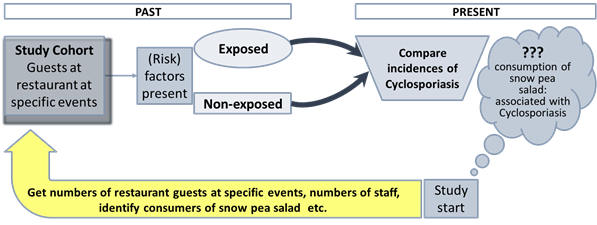1. Cohort studies
1.4. Retrospective cohort studies: Points to consider
Advantages
- useful for tracking the progress of a disease with a long latency period from study start
- can address the effects of exposures that no longer occur (e.g., discontinued medical treatments)
- are less time consuming and costly than prospective cohort studies, the actual period of interest may cover many years but the time to complete the retrospective study is only as long as it takes to collate and analyse the data
- can examine multiple effects of a single exposure, or yield information on multiple exposures
- particularly efficient for the study of rare exposures, especially occupational and “natural history” exposures
- no ethical issues in terms of collecting data if legally accessible
- not useful for the study of emerging, new exposures
- rely on existing records or subject recall which may be less accurate and complete than data collected prospectively (e.g., no records exist for the hypothesis of interest, records were not designed for the study)
- are more susceptible to the effects of bias: for example, the exposure may have occurred some years previously and adequate reliable data on exposure may be unavailable or incomplete; information on confounding variables may be unavailable, inadequate or difficult to collect
- prevent the investigator from reducing confounding and bias because collected information is restricted to data that already exists
- information on other risk factors may be inaccurate
- difficulty to identify an appropriate exposed cohort and an appropriate comparison group
- differential loss to follow up can introduce bias
- selection bias can occur since the outcomes are already known at the time of selection
Key Concept: The distinguishing feature of a retrospective cohort study is that the investigators conceive the study and begin identifying and allocating participants after exposures and outcomes have already occurred.
Example: A retrospective cohort study was used to determine the source of cyclosporiasis,
a parasitic disease that caused an outbreak among members of a residential
facility in Pennsylvania in 2004[1].
The investigation indicated that consumption of snow peas was implicated as the
vehicle of the cyclosporiasis outbreak.
A simplified schematic of this
example is shown in the following figure (Fig. 4). To note: The study was not
pre-planned. Investigator had to go back to past data that was not necessarily
acquired in a precise, predetermined way. Follow up may have been incomplete.

For interest:
It is also possible to find cohorts to study based on archived information. One
investigator used archives from a Florentine dowry investment fund to study
mortality among women who lived in Florence, Italy from 1425-1545, centuries
before the study was conducted[2].
[1] Centers for Disease Control and Prevention. Outbreak of Cyclosporiasis associated with snow peas—Pennsylvania, 2004. MMWR 2004;53:876–8. https://www.cdc.gov/mmwr/preview/mmwrhtml/mm5337a6.htm
[2] Morrison AS, Kirshner J, Molho
A. Life cycle events in 15th century Florence: records of the Monte delle doti.
Am J Epidemiol. 1977 Dec;106(6):487-92. doi:
10.1093/oxfordjournals.aje.a112496. PMID: 337798. https://pubmed.ncbi.nlm.nih.gov/337798/